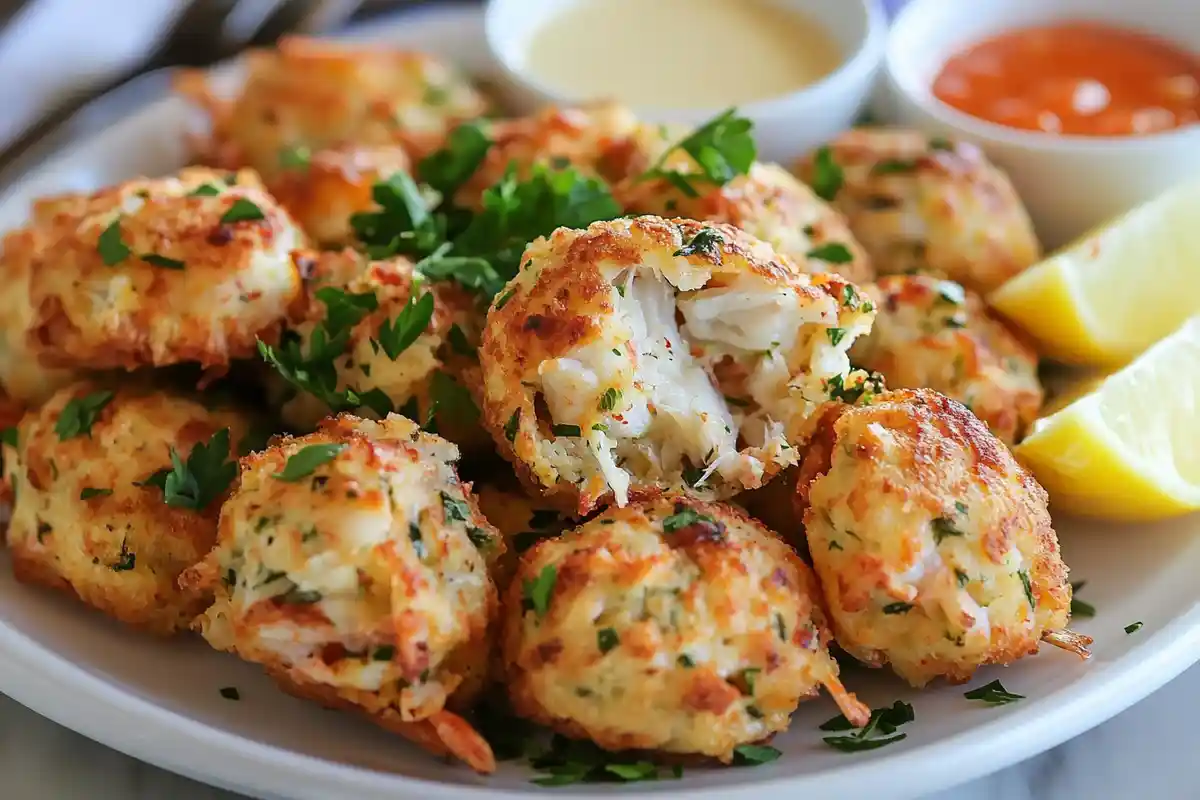Introduction to Crab Balls Recipe
Crab balls are more than just bite-sized seafood treats—they’re a culinary delight packed with rich flavors, perfect for appetizers, parties, or even a light dinner. Whether you’re a seafood lover or someone exploring new recipes, crab ball offers a blend of texture and taste that’s hard to resist. This article will guide you through every detail, from selecting the best ingredients to serving them with style. We’ll also tackle common questions like whether frying or baking works better, how to keep them firm, and even a few health insights. So, let’s dive into the irresistible world of crab balls and uncover the secrets to making them perfect every time.
Table of Contents
The Origin of Crab Balls Recipe
Originating from traditional coastal cuisines, crab balls have become a staple in seafood-loving regions like Maryland and Louisiana. Historically, they were a creative way to use leftover crab meat, transforming scraps into a mouthwatering dish.
Popularity in Coastal Cuisines
If you’ve ever visited a seaside eatery, chances are you’ve seen crab balls on the menu. From beachside shacks to upscale seafood restaurants, they’re celebrated for their convenience and rich flavor profile. Plus, they’re easy to share, making them an ideal choice for social gatherings.
Why Choose Crab Balls Over Crab Cakes?
While crab cakes have earned their place as a beloved seafood classic, crab balls offer unique advantages that make them a standout choice for many occasions.
Perfect Bite-Sized Convenience
One of the biggest perks of crab balls is their compact, snackable size. These little bites are perfect for parties, gatherings, or casual get-togethers. Their smaller shape makes them easy to handle as finger food, minimizing mess and maximizing the delicious burst of flavor in every bite.
Unmatched Versatility in Serving
Another reason crab balls steal the spotlight is their incredible versatility. Whether served as an elegant appetizer, paired with a light salad for a wholesome lunch, or presented as part of a hearty main course, crab balls seamlessly adapt to any dining setup. Plus, their shape makes them ideal for dipping into sauces—every bite is a satisfying explosion of flavor.
Cooking Made Easy
When it comes to cooking, crab balls have a practical edge over larger crab cakes. Their smaller size allows for more consistent cooking, whether you’re frying, baking, or air frying them. This ensures each piece has that perfectly golden, crispy exterior while staying tender and flavorful inside.
In short, crab balls aren’t just a miniature version of crab cakes—they’re a culinary experience of their own. Their size, versatility, and ease of preparation make them an irresistible choice for both seasoned seafood lovers and those just discovering the joy of crab-based dishes.
Ingredients for the Perfect Crab Balls
Selecting the Right Crab Meat
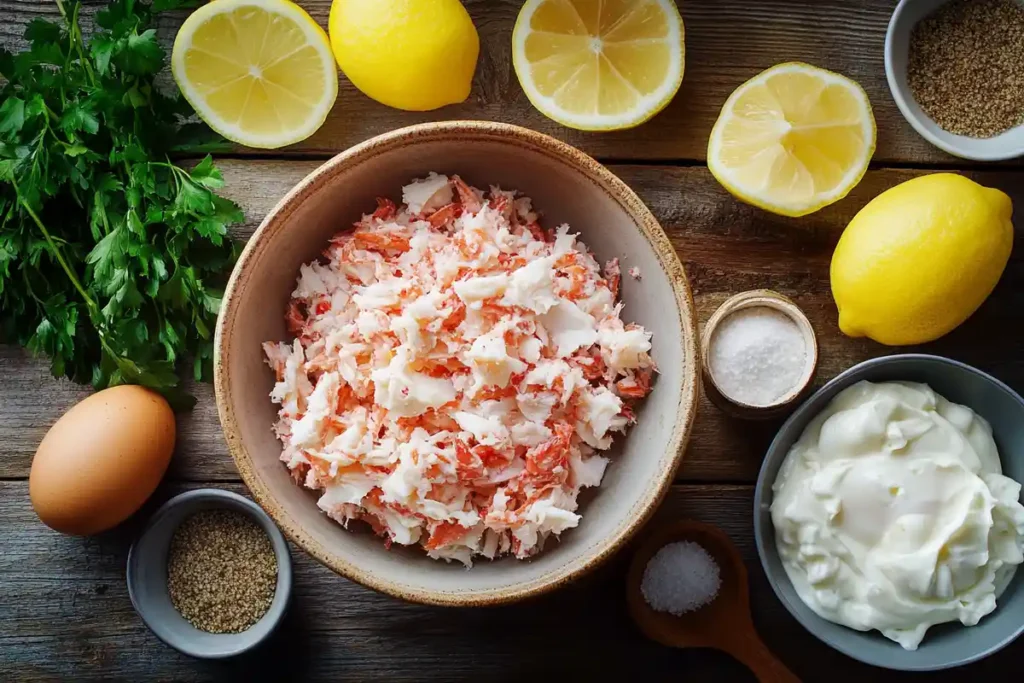
The quality of crab meat is the soul of any crab balls recipe. Choosing the right type can make or break your dish, so it’s essential to know your options.
Fresh vs. Canned Crab Meat
When it comes to crab balls, fresh crab meat is always the gold standard. It offers a tender texture and a naturally sweet flavor that’s hard to replicate with canned alternatives. However, if fresh crab meat isn’t available, high-quality canned lump crab meat can still deliver great results. Just make sure to drain it well to avoid excess moisture.
Lump vs. Backfin Crab Meat
Lump crab meat comes from the larger pieces of the crab’s body and is known for its firm texture and rich flavor. It’s ideal for recipes where you want the crab meat to stand out. On the other hand, backfin crab meat is slightly flakier and works well in dishes where the meat will be mixed thoroughly with different ingredients. For crab balls, lump crab meat is usually preferred for its chunky texture.
Essential Binding Agents
Binding agents are the unsung heroes of a successful crab balls recipe. They ensure your crab balls maintain their shape throughout the cooking process, whether you’re frying, baking, or air frying them. Without the right balance of binding ingredients, you might find yourself dealing with crumbly, falling-apart balls that won’t hold together. And let’s face it—that’s not the kind of seafood experience anyone wants.
The perfect binding mix isn’t just about structure; it also impacts the texture and flavor of your crab balls. The right combination will create crab balls that are moist and tender on the inside while holding their shape with confidence. Let’s break down the key binding agents that make this possible.
Role of Eggs and Mayonnaise
Eggs and mayonnaise are a dynamic duo when it comes to binding ingredients in crab balls.
Eggs: The Natural Glue
Eggs are a kitchen staple for a reason—they act as a natural adhesive, holding all the ingredients together seamlessly. The proteins in eggs coagulate when cooked, creating a firm structure that prevents the crab balls from falling apart. However, balance is key. Too many eggs can make the mixture rubbery, while too few might not hold everything together effectively.
Mayonnaise: The Secret Weapon
Mayonnaise, often overlooked, brings more than just binding power to the table. It adds a velvety richness and creaminess to the crab mixture, preventing it from drying out during cooking. Its emulsified texture helps evenly distribute flavors throughout the crab mixture, enhancing every bite.
Pro Tip: Use high-quality mayonnaise for the best results, and don’t overdo it—a little goes a long way.
Choosing the Right Bread Crumbs
Bread crumbs provide structure and stability to your crab mixture, ensuring that your crab balls hold their shape while remaining tender and juicy. However, not all bread crumbs are created equal, and the type you choose will affect both the texture and taste of your final dish.
Panko Bread Crumbs: Light and Crispy
Panko bread crumbs are light, airy, and delicate. They absorb moisture without becoming soggy, which helps maintain the tenderness of the crab meat while adding a crispy finish to the exterior. Panko is especially ideal if you’re frying or air frying your crab balls, as it ensures a golden-brown crust.
Traditional Bread Crumbs: Reliable and Accessible
Traditional bread crumbs, while denser than panko, also work well as a binding agent. They absorb moisture effectively, helping to hold the crab mixture together. These are a great choice if you’re baking your crab balls since they create a firm structure without excessive crispiness.
Alternative Options: Gluten-Free and Beyond
For those avoiding gluten, almond flour or crushed gluten-free crackers can serve as excellent substitutes for traditional bread crumbs. They’ll still provide the necessary structure while keeping the dish allergen-friendly.
Pro Tip: Avoid overloading the mixture with bread crumbs, as too much can overshadow the delicate crab flavor and create a dry texture.
Flavor Enhancers and Seasonings
While binding agents focus on structure, flavor enhancers bring your crab balls recipe to life. The right blend of spices, herbs, and aromatics ensures that every bite is bursting with savory goodness.
Traditional Spices (e.g., Old Bay Seasoning)
No crab recipe is complete without Old Bay seasoning. This iconic spice mix, with its blend of celery salt, paprika, black pepper, and a touch of heat, is a match made in heaven for crab meat. It enhances the natural sweetness of the crab without overpowering it.
If Old Bay isn’t available, a mix of paprika, garlic powder, and a dash of cayenne pepper can work as a suitable replacement.
Fresh Herbs and Aromatics
Fresh herbs like parsley, chives, and cilantro add a pop of color and freshness to your crab balls. They not only enhance the presentation but also balance the richness of the crab meat and mayonnaise.
Aromatics such as minced garlic, shallots, and finely chopped onions introduce depth and complexity to the flavor profile. They create an underlying savoriness that ties all the ingredients together beautifully.
Pro Tip: Chop your herbs and aromatics finely to ensure even distribution throughout the crab mixture.
The Perfect Balance
Creating the perfect crab ball mixture is all about balance. Too many eggs can make them rubbery, while too few will leave them fragile. Too many bread crumbs can make them dry, while too few won’t provide enough structure. And, of course, seasonings need to complement, not overwhelm, the star ingredient: crab meat.
Take your time when mixing the ingredients. Gently fold them together to maintain the texture of the crab meat, and always taste-test a small portion of the mixture before cooking to ensure the seasoning is just right.
Step-by-Step Preparation Guide
Preparing the Crab Meat Mixture
This step sets the foundation for your crab balls recipe. A perfectly balanced mixture ensures your balls are flavorful and structurally sound.
Cleaning and Picking the Crab Meat
Before mixing, make sure your crab meat is clean and free from shell fragments. Gently pick through it using your fingers to avoid breaking up the larger chunks.
Combining Ingredients
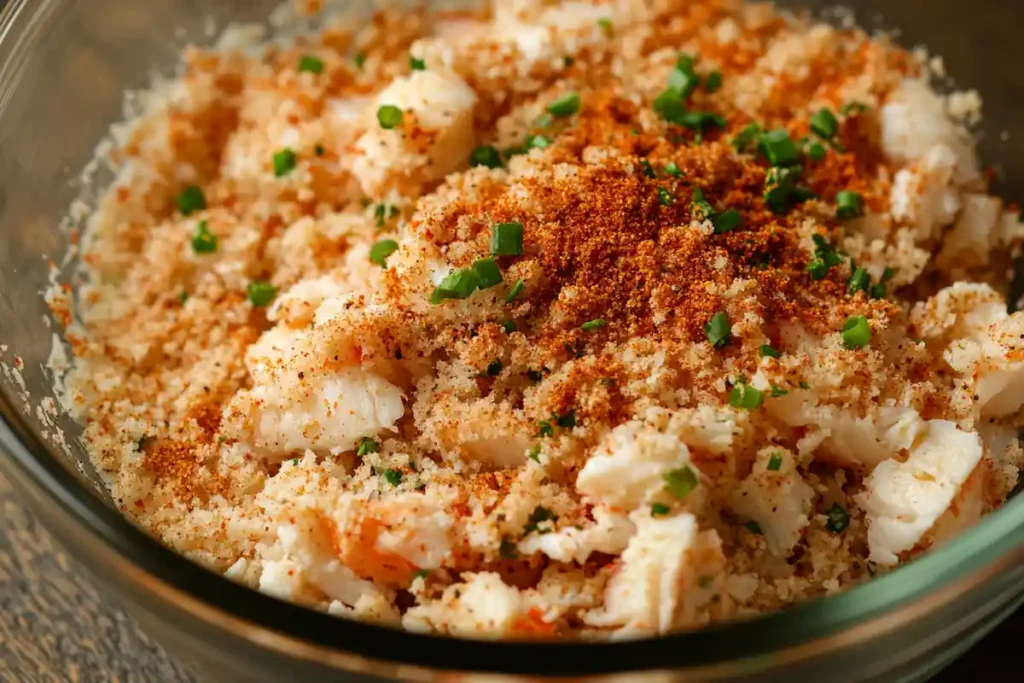
In a large mixing bowl, combine the crab meat with eggs, mayonnaise, breadcrumbs, and your chosen seasonings. Use a gentle folding motion to mix—overmixing can break down the crab meat and make your crab balls dense.
Shaping the Crab Balls
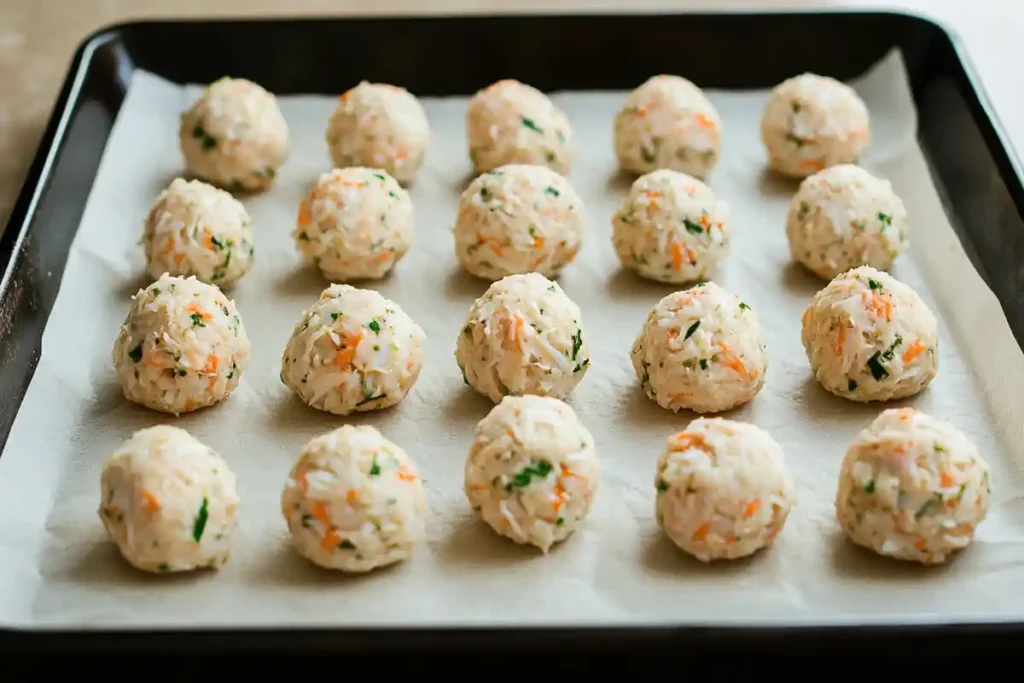
Now that your mixture is ready, it’s time to form the crab balls.Using a small ice cream scoop or your hands, shape the mixture into evenly sized-balls. Aim for about one inch in diameter for bite-sized perfection.To help your crab balls hold their shape, let them chill in the refrigerator for at least 30 minutes before cooking. This step firms up the mixture and prevents the balls from falling apart during frying or baking.
Cooking Methods
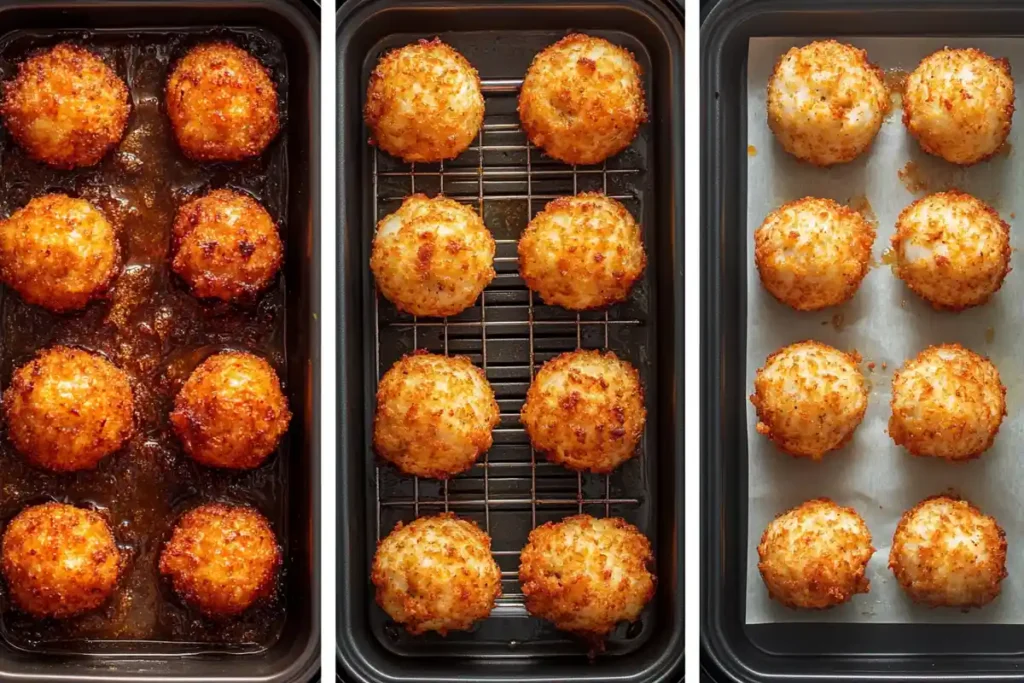
When it comes to cooking crab balls, you’ve got options. Each method offers a slightly different result, so choose what suits your preference. Whether you want a crispy golden crust, a healthier baked version, or the convenience of an air fryer, there’s a method tailored just for you. Below, we’ll dive into the three most popular cooking techniques: frying, baking, and air frying.
Frying Crab Balls
Frying is the go-to method for achieving that classic golden-brown, crispy exterior while keeping the inside tender and juicy. It’s a favorite among seafood lovers for its rich flavor and delightful crunch.
Draining Excess Oil: Once fried to golden perfection, transfer the crab balls onto a paper towel-lined plate to drain any excess oil.
Oil Selection: Use a neutral oil with a high smoke point, such as vegetable oil, canola oil, or peanut oil. Avoid olive oil, as its smoke point is too low for deep frying.
Temperature Control: Heat the oil to around 350°F to 375°F (175°C to 190°C). Maintaining the right temperature is crucial; too hot, and the balls will burn on the outside while remaining raw inside. Too cold, and they’ll absorb excess oil and become greasy.
Cooking Process: Gently place the crab balls in the hot oil, being careful not to overcrowd the skillet. Fry them for about 3-4 minutes, turning occasionally to ensure even browning.
Baking Crab Balls
Baking offers a healthier alternative without sacrificing flavor. It’s a fantastic option if you’re cooking for a crowd or prefer a hands-off approach.
Finishing Touch: For extra crispiness, broil them for an additional 1-2 minutes at the end of the baking time.
Preheating the Oven: Preheat your oven to 375°F (190°C). A properly heated oven ensures even cooking and prevents sogginess.
Preparing the Tray: Line a baking sheet with parchment paper or lightly grease it with cooking spray to prevent sticking.
Arranging the Crab Balls: Place the shaped crab balls on the tray, ensuring they’re evenly spaced to allow heat circulation.
Cooking Time: Bake for approximately 15-20 minutes, flipping them halfway through for even browning.
Air Fryer Method
Air frying is the modern twist on traditional frying, offering the crispy texture of frying with significantly less oil. It’s quick, efficient, and a great option for those watching their calorie intake.
Final Touch: Check for a crispy, golden exterior before removing them from the basket.
Preheating the Air Fryer: Preheat your air fryer to 375°F (190°C). Proper preheating ensures even cooking and crispiness.
Arranging the Crab Balls: Place the crab balls in the air fryer basket in a single layer, leaving space between them for airflow. Overcrowding can result in uneven cooking.
Cooking Time: Cook the crab balls for about 10-12 minutes, shaking the basket halfway through to ensure they brown evenly on all sides.
Serving Suggestions and Accompaniments
Ideal Dipping Sauces
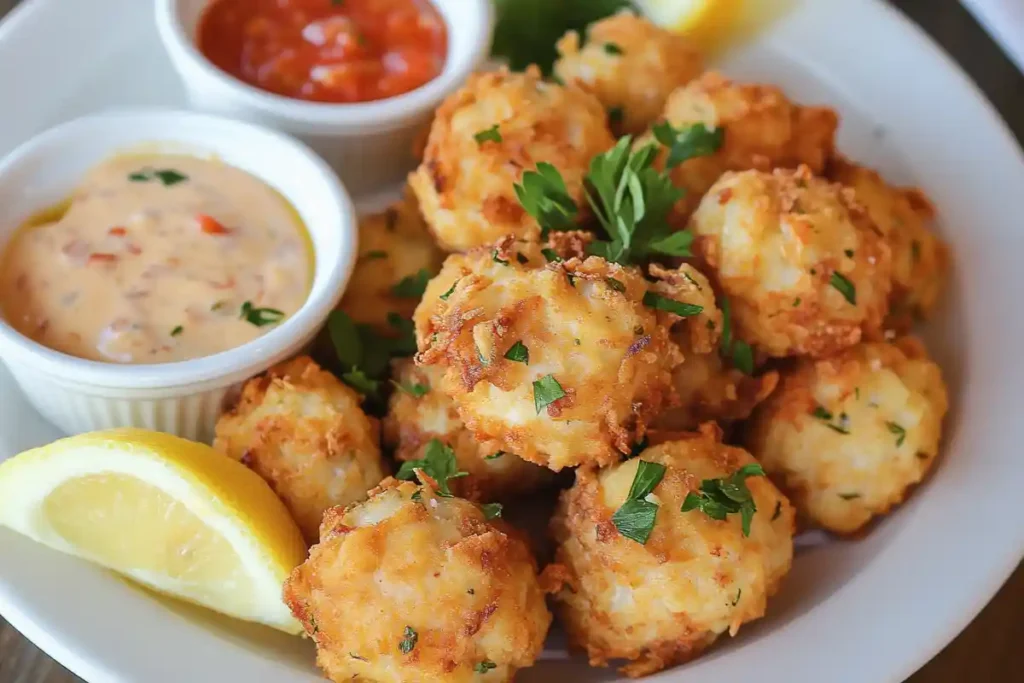
No crab balls recipe is complete without a delicious dipping sauce. The right sauce not only enhances the flavor but also adds a layer of richness or tang that makes each bite irresistible.
Classic Tartar Sauce
A timeless favorite, tartar sauce combines mayonnaise, chopped pickles, capers, and a splash of lemon juice. Its creamy texture and tangy flavor pair beautifully with the crispy, golden crust of crab balls. Add some fresh dill for an extra burst of flavor.
Spicy Remoulade
If you like a little heat with your seafood, spicy remoulade is your go-to sauce. This zesty blend of mayonnaise, mustard, paprika, and a hint of hot sauce brings bold flavors to the table. It’s a game-changer for dipping crab balls.
Side Dishes to Complement Crab Balls
Pairing crab balls with the right side dishes transforms them from a simple appetizer into a full meal.
Fresh Salads
A light, refreshing salad with crisp greens, cherry tomatoes, and a citrus vinaigrette complements the richness of crab balls. It balances the flavors and adds a touch of brightness to your plate.
Roasted Vegetables
For a heartier option, roasted vegetables such as asparagus, zucchini, or bell peppers bring earthy flavors and a hint of caramelization to your seafood platter.
Presentation Tips for Entertaining
Presentation is everything, mainly when serving crab balls at gatherings or dinner parties.
Plating Techniques
Arrange your crab balls on a platter lined with fresh greens or lemon wedges for a vibrant presentation. Use a small dipping bowl for sauces and place it in the center for easy access.
Garnishing Ideas
Garnish your dish with fresh parsley, chives, or a sprinkle of Old Bay seasoning. A final drizzle of lemon juice just before serving adds an extra pop of freshness.
Frequently Asked Questions (FAQs)
Is it better to fry or bake crab cakes?
The choice between frying and baking crab balls depends on your preference. Frying gives them a crispy, golden-brown crust and an indulgent texture while baking offers a healthier alternative with fewer calories. If you’re hosting a large gathering, baking might be more practical, as it allows you to cook multiple crab balls simultaneously.
What makes crab cakes stick together?
The secret to keeping your crab balls intact lies in the binding agents. Eggs and mayonnaise act as the glue, while breadcrumbs provide structure. Make sure your crab mixture isn’t too wet or too dry. Additionally, chilling the mixture before shaping and cooking helps it firm up and hold its shape during cooking.
Why do you soak crabs in milk?
Soaking crab meat in milk helps neutralize any strong, fishy odors and enhances the natural sweetness of the meat. This is particularly helpful if you’re using canned crab meat, which can sometimes have a metallic or overly briny taste.
Are crab balls good for you?
Yes, crab balls can be a healthy option when prepared mindfully. Crab meat is naturally low in fat, high in protein, and packed with essential nutrients like vitamin B12, zinc, and selenium. However, frying adds extra calories, so baking or air frying is a healthier cooking choice.
Can I make crab balls ahead of time?
Absolutely! You can prepare the crab balls mixture, shape them, and store them in the refrigerator for up to 24 hours before cooking. If you want to store them longer, freeze them and cook them directly from frozen—adjust the cooking time slightly.
How do I prevent crab balls from falling apart?
The key to preventing crab balls from falling apart is balance. Use enough binding agents like eggs and mayonnaise, avoid overmixing, and always chill the mixture before cooking. Additionally, be gentle when flipping them during frying or baking.
Conclusion
Recap of Key Points
Creating the perfect crab balls recipe is a delightful journey that combines quality ingredients, thoughtful preparation, and a touch of creativity. From selecting the right crab meat—whether fresh or canned, lump or backfin—to using essential binding agents like eggs, mayonnaise, and breadcrumbs, every step plays a crucial role. We explored the different cooking methods, from frying for a crispy texture to baking for a healthier option and even air frying for convenience.
Pairing these golden bites with the right dipping sauces, such as tartar sauce or spicy remoulade, and serving them with refreshing side dishes like fresh salads or roasted vegetables, elevates them from a simple appetizer to a star attraction. Plus, with the helpful tips from our FAQs section, you’re now equipped to handle everyday challenges, whether it’s keeping the mixture firm, preventing it from falling apart, or deciding on the best cooking method.
Encouragement to Try the Recipe
Cooking is as much about the experience as it is about the result. So don’t hesitate to roll up your sleeves, gather your ingredients, and create these delicious crab balls in your kitchen. Whether you’re hosting a dinner party, planning a family meal, or simply treating yourself to something special, these flavorful seafood bites are sure to impress.
Remember, the beauty of crab balls lies in their versatility—they’re perfect for both casual snacking and elegant presentations. So, go ahead and give this crab balls recipe a try. With the right techniques and a little patience, you’ll master this dish in no time. Enjoy every bite!
If you missed any of the earlier parts or need a refresher on preparation and cooking techniques, feel free to revisit the sections above. Happy cooking! 🍽️✨

